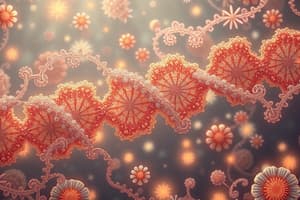Podcast
Questions and Answers
What do transcription factors primarily control?
What do transcription factors primarily control?
- The interaction of RNA with ribosomes
- The structure of RNA molecules
- The transcription of genes (correct)
- The stability of DNA
How do transcription factors enhance promoter effectiveness?
How do transcription factors enhance promoter effectiveness?
- By positioning RNA polymerase effectively (correct)
- By preventing the binding of micro-RNAs
- By decreasing the affinity of RNA polymerase
- By increasing the stability of mRNA molecules
What role do micro-RNAs play in gene regulation?
What role do micro-RNAs play in gene regulation?
- They have no effect on gene regulation
- They serve as a primary energy source for transcription
- They inhibit transcription factors directly
- They can affect the stability of mRNA (correct)
What is a key approach mentioned for analyzing regulatory networks of genes?
What is a key approach mentioned for analyzing regulatory networks of genes?
Why are regulatory networks significant in cancer research?
Why are regulatory networks significant in cancer research?
What is the predominant level at which eukaryotes regulate gene expression?
What is the predominant level at which eukaryotes regulate gene expression?
What does constitively expressed mean in terms of gene regulation?
What does constitively expressed mean in terms of gene regulation?
Which of the following is NOT a potential outcome when there’s a change in gene activity?
Which of the following is NOT a potential outcome when there’s a change in gene activity?
What is meant by 'regulatory networks' in the context of gene expression?
What is meant by 'regulatory networks' in the context of gene expression?
Which of the following is a key mechanism of post-transcriptional regulation?
Which of the following is a key mechanism of post-transcriptional regulation?
What is one significant effect of pseudo-uridination on RNA?
What is one significant effect of pseudo-uridination on RNA?
Which of the following is NOT mentioned as a method of modifying RNA?
Which of the following is NOT mentioned as a method of modifying RNA?
How many unique modifications can RNA undergo according to the content?
How many unique modifications can RNA undergo according to the content?
What role does modifying RNA play in regulating its function?
What role does modifying RNA play in regulating its function?
Which of the following is a chemical modification mentioned for DNA?
Which of the following is a chemical modification mentioned for DNA?
What is the primary reason the lac operon is not activated in the absence of lactose?
What is the primary reason the lac operon is not activated in the absence of lactose?
In what situation would the TRIP operon be turned off?
In what situation would the TRIP operon be turned off?
What role does cyclic AMP play in relation to the lac operon?
What role does cyclic AMP play in relation to the lac operon?
What is a crucial factor influencing the translation capability of mRNA in the TRIP operon?
What is a crucial factor influencing the translation capability of mRNA in the TRIP operon?
Why do transcription and translation influence each other in prokaryotes?
Why do transcription and translation influence each other in prokaryotes?
What correlation is noted between dysfunction in processing and human conditions?
What correlation is noted between dysfunction in processing and human conditions?
In the context of transcription factors, what does a circle in the diagram represent?
In the context of transcription factors, what does a circle in the diagram represent?
What is indicated by the connections or shapes in the figure discussed?
What is indicated by the connections or shapes in the figure discussed?
What are the 'big takeaways' related to regarding operons as mentioned?
What are the 'big takeaways' related to regarding operons as mentioned?
What major concept is illustrated by the circular statement regarding RNA modification?
What major concept is illustrated by the circular statement regarding RNA modification?
What role do charged tRNAs play when tryptophan levels are sufficient?
What role do charged tRNAs play when tryptophan levels are sufficient?
How can small interfering RNAs (siRNAs) affect mRNA?
How can small interfering RNAs (siRNAs) affect mRNA?
What is one way eukaryotes regulate translation?
What is one way eukaryotes regulate translation?
What overall effect does changing the accessibility of RNA have on cellular function?
What overall effect does changing the accessibility of RNA have on cellular function?
What happens to translation when there is a surplus of dietary components?
What happens to translation when there is a surplus of dietary components?
What is a characteristic feature of repressible operons, such as the trp operon?
What is a characteristic feature of repressible operons, such as the trp operon?
How do iron response elements (IREs) influence gene regulation in response to iron deficiency?
How do iron response elements (IREs) influence gene regulation in response to iron deficiency?
Which phrase best describes the concept of functional heterogeneity in cell populations?
Which phrase best describes the concept of functional heterogeneity in cell populations?
What do regulatory proteins interact with to control gene expression?
What do regulatory proteins interact with to control gene expression?
What is the primary role of attenuation in gene regulation?
What is the primary role of attenuation in gene regulation?
What is the primary mechanism of transcriptional regulation in eukaryotes?
What is the primary mechanism of transcriptional regulation in eukaryotes?
Which of the following best describes constitutive gene expression?
Which of the following best describes constitutive gene expression?
How do epigenetic changes in DNA methylation affect gene expression?
How do epigenetic changes in DNA methylation affect gene expression?
What is a consequence of errors in post-transcriptional processing?
What is a consequence of errors in post-transcriptional processing?
What potential effect do regulatory networks have on cancer genetics?
What potential effect do regulatory networks have on cancer genetics?
What role do microRNAs have alongside transcription factors in gene regulation?
What role do microRNAs have alongside transcription factors in gene regulation?
What is the implication of heritable gene expression profiles in multicellular organisms?
What is the implication of heritable gene expression profiles in multicellular organisms?
What is the impact of pseudouridylation on RNA molecules?
What is the impact of pseudouridylation on RNA molecules?
Which of the following statements about gene regulatory networks is true?
Which of the following statements about gene regulatory networks is true?
In the context of gene regulation, what is a significant feature of inducible genes?
In the context of gene regulation, what is a significant feature of inducible genes?
Flashcards
Eukaryotic gene regulation
Eukaryotic gene regulation
Primarily happens at the transcription level, but other levels like post-transcriptional, translational, and post-translational are also important.
Constitutively expressed genes
Constitutively expressed genes
Genes that are always on; they are essential for basic cellular functions.
Post-transcriptional regulation
Post-transcriptional regulation
Controlling gene expression after transcription; includes mRNA processing, localization, export, import, translation, and protein modification.
Gene expression levels
Gene expression levels
Signup and view all the flashcards
Gene expression pathway
Gene expression pathway
Signup and view all the flashcards
Transcription factors
Transcription factors
Signup and view all the flashcards
Regulatory networks
Regulatory networks
Signup and view all the flashcards
Transcription factors
Transcription factors
Signup and view all the flashcards
RNA polymerase
RNA polymerase
Signup and view all the flashcards
Regulatory networks
Regulatory networks
Signup and view all the flashcards
Computational analysis
Computational analysis
Signup and view all the flashcards
Micro-RNAs
Micro-RNAs
Signup and view all the flashcards
Gene regulation
Gene regulation
Signup and view all the flashcards
Binding domains
Binding domains
Signup and view all the flashcards
Cellular processes
Cellular processes
Signup and view all the flashcards
Cancer research
Cancer research
Signup and view all the flashcards
RNA Modification
RNA Modification
Signup and view all the flashcards
Pseudo-uridine
Pseudo-uridine
Signup and view all the flashcards
RNA Regulation (Chemical)
RNA Regulation (Chemical)
Signup and view all the flashcards
tRNA Modification Examples
tRNA Modification Examples
Signup and view all the flashcards
DNA Modifications (heritable)
DNA Modifications (heritable)
Signup and view all the flashcards
Inactive X Chromosome
Inactive X Chromosome
Signup and view all the flashcards
Transcription factor function
Transcription factor function
Signup and view all the flashcards
RNA modification examples
RNA modification examples
Signup and view all the flashcards
Operon regulation (on/off)
Operon regulation (on/off)
Signup and view all the flashcards
Human conditions & RNA processing steps
Human conditions & RNA processing steps
Signup and view all the flashcards
Regulatory network visualization
Regulatory network visualization
Signup and view all the flashcards
mRNA regulation
mRNA regulation
Signup and view all the flashcards
Translational regulation
Translational regulation
Signup and view all the flashcards
Small interfering RNAs (siRNAs)
Small interfering RNAs (siRNAs)
Signup and view all the flashcards
Antisense RNA
Antisense RNA
Signup and view all the flashcards
RNA accessibility
RNA accessibility
Signup and view all the flashcards
Environmental factors & translation
Environmental factors & translation
Signup and view all the flashcards
Negative feedback regulation
Negative feedback regulation
Signup and view all the flashcards
Lac Operon Regulation
Lac Operon Regulation
Signup and view all the flashcards
Lac Operon 'off' signal
Lac Operon 'off' signal
Signup and view all the flashcards
TRP Operon Regulation
TRP Operon Regulation
Signup and view all the flashcards
TRP Operon 'on' signal
TRP Operon 'on' signal
Signup and view all the flashcards
Attenuation
Attenuation
Signup and view all the flashcards
Transcription and Translation Coupling
Transcription and Translation Coupling
Signup and view all the flashcards
Constitutive gene
Constitutive gene
Signup and view all the flashcards
Coordinate regulation
Coordinate regulation
Signup and view all the flashcards
Operator (gene)
Operator (gene)
Signup and view all the flashcards
Promoter (gene)
Promoter (gene)
Signup and view all the flashcards
Regulatory element
Regulatory element
Signup and view all the flashcards
Regulatory protein
Regulatory protein
Signup and view all the flashcards
Inducible gene
Inducible gene
Signup and view all the flashcards
Repressible gene
Repressible gene
Signup and view all the flashcards
aporepressor
aporepressor
Signup and view all the flashcards
Iron response element
Iron response element
Signup and view all the flashcards
Attenuation
Attenuation
Signup and view all the flashcards
Gene Regulation by Environment
Gene Regulation by Environment
Signup and view all the flashcards
Promoters
Promoters
Signup and view all the flashcards
Operators
Operators
Signup and view all the flashcards
Regulatory Elements
Regulatory Elements
Signup and view all the flashcards
Regulatory Proteins
Regulatory Proteins
Signup and view all the flashcards
Constitutive Genes
Constitutive Genes
Signup and view all the flashcards
Inducible Genes
Inducible Genes
Signup and view all the flashcards
Repressible Genes
Repressible Genes
Signup and view all the flashcards
DNA Mutations
DNA Mutations
Signup and view all the flashcards
Gene Expression Pathway
Gene Expression Pathway
Signup and view all the flashcards
Eukaryotic Gene Regulation
Eukaryotic Gene Regulation
Signup and view all the flashcards
Post-transcriptional Regulation
Post-transcriptional Regulation
Signup and view all the flashcards
RNA Modifications
RNA Modifications
Signup and view all the flashcards
Heritable Gene Expression
Heritable Gene Expression
Signup and view all the flashcards
Gene Regulatory Networks
Gene Regulatory Networks
Signup and view all the flashcards
Study Notes
Eukaryotic Transcription Regulation
- Eukaryotes primarily regulate gene expression at the transcriptional level, unlike prokaryotes.
- Essential genes are often constitutively expressed, meaning always turned on.
- Regulation involves various steps, including transcription, post-transcriptional processing, localization, import/export, translation, and degradation.
- Changes in gene activity can increase, decrease or have no effect on activity levels.
- Deregulation can lead to adverse outcomes.
- Gene expression is considered a pathway, with multiple factors affecting each step.
Transcription Factors
- Transcription factors control transcription by influencing RNA polymerase binding to DNA.
- High-affinity promoters are activated rapidly, while lower-affinity promoters respond more slowly.
- A single transcription factor can control numerous genes.
- Regulatory networks involve complex interactions between multiple genes and factors, affecting various cellular processes like migration.
RNA Modifications
- RNA molecules undergo numerous modifications, impacting RNA function and stability.
- Chemical modifications and splicing significantly impact RNA function.
- Pseudo-uridylation is an example of RNA modification influencing translation and mRNA stability.
- Modifications can affect base pairing and overall conformation of the molecule.
- Modifications are crucial for regulating cellular processes and influencing expression.
Heritable Gene Expression Patterns
- Clonal identities show functional heterogeneity, even with genetically identical cells.
- Expression patterns can differ in clonal populations, affecting responses to treatments.
- The liver and brain have different gene expression patterns.
- Environmental factors can influence heritable expression patterns.
Prokaryotic Gene Regulation
- Prokaryotic systems commonly use inducible and repressible systems for gene regulation.
- Catabolic enzymes are often inducible, while anabolic enzymes are typically repressible.
- The operon model links multiple genes involved in a single metabolic pathway.
- Operators inhibit expression of controlled genes.
- Lactose presence in the system affects the regulation of the operon.
- Glucose presence inhibits expression of controlled genes.
Studying That Suits You
Use AI to generate personalized quizzes and flashcards to suit your learning preferences.




